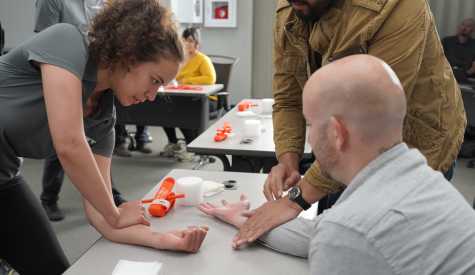9 Reasons Teams Avoid Active Shooter Response Training

In recent years, we’ve seen a rise in violence in many parts of the United States. Sometimes it feels like you can’t turn on the TV or scan the internet without hearing about a new tragedy. Schools, businesses, open spaces, and other public places have become targets for mass killings, often at the hands of an active shooter. So, if you want to ensure a safe work environment for your team, it’s crucial to prepare for potential active shooter situations.
Many organizations mistakenly avoid active shooter response training. For some, this avoidance stems from fear. For others, barriers such as not knowing where to start stand in their way.
Let’s look at some of the most common misconceptions that prevent businesses from investing in active shooter training for their team.
1. Having a false sense of security: “It won’t happen here.”
Some organizations are lulled into a false sense of security, believing they are immune to the threat of an active shooter event. This is the business equivalent of, “It won’t happen to me”.
They might perceive active shooter incidents as rare and unlikely to occur in general. In this case, it’s a mindset of, “The odds are in our favor”, and they fail to acknowledge the need for training. This leads to a lack of preparedness on a large scale within the organization.
2. Underestimating risk: “My industry isn’t a target.”
Organizations may look at big news stories and assume their type of business isn’t a target for active shooter events. Or maybe they think their location isn’t susceptible to such threats. The reality is that active violence can and does occur in all organizations, including:
- Corporations
- Places of worship
- Government buildings
- Healthcare facilities
- Schools and universities
- Small and large venues
- Retail environments
- Supermarkets and shopping centers
- Public transportation
- Nightclubs and bars
Recent active shooter incidents have ranged from car shows, crowded subway cars, grocery stores, K-12 schools, hospitals, parades… unfortunately, the list goes on. No matter the industry or type of organization, your team deserves to be prepared.
3. Assuming the best: “Our employees are happy.”
Businesses can fall into the trap of denial, believing they have a solid workplace culture where disgruntled employees use normal channels of communication to resolve issues. But here’s the catch: Active violence doesn’t always make sense. In fact, oftentimes the selection of victims is random or stems from something unassociated with the active shooter’s target.
A staff member or former employee might have hidden personal issues, such as mental health problems or other major external stressors (e.g., financial difficulties, divorce, etc.). There might be workplace conflict or serious job dissatisfaction that flies under the radar.
Warning signs can be missed, especially when you assume everyone is content and do not provide situational awareness training for your team.
4. Being overconfident: “We have security cameras.”
Maybe your organization has safety measures in place, such as surveillance cameras, controlled entry systems or even a security guard. These tools can be of great value in terms of creating a safe location for employees and hopefully deterring individuals from making your business a target.
Regardless of these efforts, a determined individual will often find a way. Security cameras might help document the incident and allow law enforcement officers to arrive on scene faster. But technology can’t intervene in an active attack. Instead, the people on the ground are going to be your best option to help in emergency situations.
5. Lacking resources: “We don’t have the money or time.”
As with any type of training or workplace initiative, there might be pushback related to limited funding or other business issues. For example, organizations often face time constraints, making it challenging to schedule training sessions for their team.
Additionally, immediate operational needs may take priority or other training programs that are considered more critical, pushing active shooter training further down the list.
If an active violence or emergency bleeding situation happens, the benefit of having trained employees and team members far outweigh the costs.
6. Intimidating subject: “It feels scary to think about.”
Leadership might choose to avoid active shooter response training due to concerns about creating a panic among employees. For example, they might not want their team to think that training is a direct reflection of an unsafe or unstable work environment. Alternatively, they might worry the training itself could induce discomfort, anxiety, or fear from discussing and practicing responses to violent acts.
An active shooter incident is a difficult subject, but having a plan in place instills confidence in people. Training can be done in a safe and inclusive environment that helps to empower individuals and foster teamwork.
7. Misjudging the need: “Maybe someday we’ll get training.”
We all have long "to-do” lists and a limited amount of time to get things done. If your organization has put off active shooter response training due to competing priorities, at what point does it become necessary? Usually only after an active violence incident near or at your location will the need for training become a priority.
8. Not having the expertise: “Where do we even start?”
Implementing effective active shooter response training requires specialized knowledge and expertise. Organizations may not have access to an in-house trainer or the know-how to create and deliver a comprehensive training program. In this case, hiring a reputable, authorized training center that can provide training is recommended.
9. Overlooking liabilities: “It’s not required training.”
OSHA does not currently have specific standards for workplace violence. However, under the General Duty Clause, Section 5(a)(1) of the Occupational Safety and Health Act of 1970, employers are required to provide their employees with a place of employment that is “free from recognized hazards that are causing or are likely to cause death or serious physical harm.”
The courts have interpreted OSHA's general duty clause to mean that an employer has a legal obligation to provide a workplace free of conditions or activities that either the employer or industry recognizes as hazardous and that cause, or are likely to cause, death or serious physical harm to employees when there is a feasible method to abate the hazard.
OSHA has developed Enforcement Procedures and Scheduling for Occupational Exposure to Workplace Violence, which provides guidance and procedures to be followed when conducting inspections and issuing citations related to the occupational exposure to workplace violence.
AVIRT is for everyone
The reasons above may explain why organizations often avoid active shooter response training. However, promoting employee safety and providing training on how to respond to an active shooter event must be prioritized.
Taking a proactive approach to active shooter response training will give your team a plan of action. This instills confidence in individuals and the overall group.
With AVIRT (Active Violence Immediate Response Training), your team will learn situational awareness, giving them the ability to recognize warning signs and help prevent violent behavior. They’ll also learn how to take immediate action to protect themselves and others in a violent situation. This includes how to identify an accessible escape path and evade their attacker by finding a protective hiding place.
Along with active shooter response training, participants are taught important stop the bleed techniques to help control emergency bleeding. This means they may save their own life or help to save the lives of others while waiting for first responders to arrive on the scene.
During training, AVIRT creates a safe learning environment to discuss and learn about a difficult subject. It also gives each team member the opportunity to practice responding to a simulated incident to improve their chance of survival.
Get active shooter training for your team
No matter your industry, budget or workplace culture, active shooter training should be part of your emergency action plan. Learn more about how your team can benefit from active shooter and bleeding control training through in-house and on-site training with HSI’s AVIRT program.



